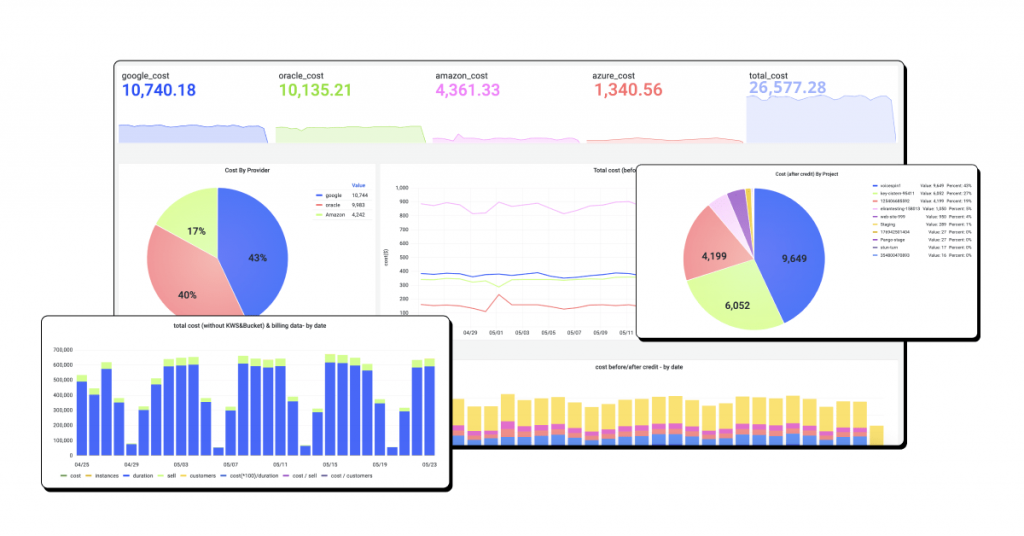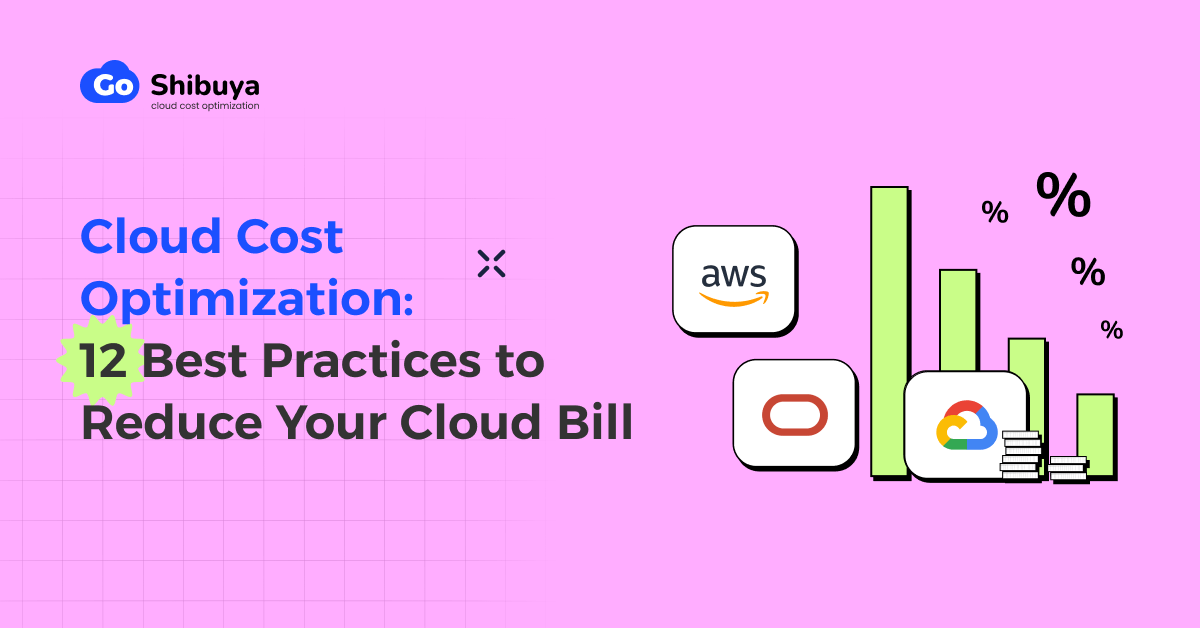As more organizations continue moving to the cloud environment and intend to increase their spending on cloud services in the following years, many are struggling to handle their cloud costs effectively. Considering that over 30% of cloud spend is wasted, which may translate to huge financial losses for businesses, no wonder cloud cost optimization becomes essential.
With the right cloud cost optimization strategy in place, businesses can reduce unnecessary cloud spending, make more informed decisions about budgeting, and manage their cloud resources more efficiently. That ultimately means increased business revenue and profitability in the long run.
Uncover opportunities to optimize your cloud, simplify cloud management, and reduce costs.
In this blog, we’re breaking down why cloud cost optimization becomes more of a priority for businesses and providing the top 12 best strategies you can implement to reduce your cloud bill.
What is Cloud Cost Optimization?
Cloud cost optimization involves using various techniques, cloud cost management strategies, best practices, and tools to reduce cloud costs without compromising the quality or availability of the cloud computing services being used while also maximizing their business value. Cloud cost optimization strategies may vary from identifying and minimizing mismanaged or excess resources and rightsizing computing services to leveraging automation and data-driven modeling and forecasting, etc.
Manage your single or multi-cloud infrastructure and cut down on your cloud bill.

Why Cloud Cost Optimization is Becoming Critical
Cloud systems provide businesses with great scalability, flexibility, and security, they are mostly unaware of how much they overspend on their cloud services and how to manage these costs in the most optimal way.
In fact, a recent Flexera 2023 State of the Cloud Report revealed that managing cloud spend is the top challenge for 82% of the survey respondents from across all organizations. That said, nearly half (45%) of respondents indicated that their expected cloud usage and spend is somewhat or significantly higher than planned.
Here are some more compelling findings on how cloud financial management impacts the bottom line. According to 451 Research’s whitepaper ‘Cloud Financial Management, Small Changes Can Make Big Impacts’, the survey respondents managed to save 56% of their cloud costs as a result of applying Cloud Financial Management practices in their organization. At the same time, 67% said they have used CFM practices to grow revenue, and 64% stated that they improved their profitability because of CFM.
All in all, optimizing cloud costs and leveraging smart cloud financial management strategies helps businesses and organizations that rely on cloud computing achieve:
- Significant cloud cost savings
- Better resource allocation
- Increased business revenue
- Improved business profitability
- More informed decision-making
12 Best Practices to Reduce Your Cloud Costs
By implementing various cloud cost optimization best practices and using professional cloud cost optimization tools, organizations can save money on their cloud bills, allocate resources more effectively, and ensure they are using the services of their cloud providers as cost-efficiently as possible. Here are the top 12 ways to optimize cloud costs:
1. Rightsize your computing resources
Rightsizing your computing resources is one of the most efficient ways to optimize costs and ensure that you are using just the right amount of resources needed to support your workloads. That involves identifying, analyzing, and modifying your cloud resources to the most efficient size to meet the unique requirements of individual applications and workloads.
With hundreds of different instance types offered by Amazon Web Services (AWS), you can use a number of tools to analyze your current usage patterns and determine the optimal instance type and size to fit your performance requirements while minimizing cloud costs.
2. Consistently monitor cost anomalies

Keeping track of cost anomalies is another essential step in optimizing your cloud spend and preventing unexpected costs. They can occur in the cases of sudden spikes in resource usage or changes in the pricing of cloud service providers. You should be aware of these events as soon as possible before your expenses go out of control and wreak havoc on your budget.
By monitoring and identifying cost anomalies and their root cause, you can take timely corrective measures. That can be done by using various tools, allowing you to set real-time alerts that notify you when you exceed expected spending thresholds.
3. Opt for the best storage type
Choosing the right storage type for your use case is an often overlooked yet critical aspect of cloud cost optimization. E.g., ASW offers several storage tiers with significantly different costs, so selecting the right tier is essential to avoiding unnecessary overspending.
If you have data that is infrequently accessed or can tolerate slower retrieval times, consider using lower-cost archival storage options like Amazon S3 Glacier or Amazon S3 Glacier Deep Archive. If unsure, you can opt for Amazon S3 Intelligent Tiering, which automatically moves data to the most cost-effective access tier when access patterns change.
4. Identify unused and idle resources
Regularly monitoring, identifying, and removing unused resources is an important step in the cloud cost optimization process, as they can be a source of huge wasted cloud spending. That may include, for instance, terminating unused instances or databases.
Cloud providers would still charge you for those resources even though you are not using them anymore, which means a solid amount of your cloud costs is simply wasted. The same is true for idle resources that are currently active but underused and that should be consolidated to help you eliminate unnecessary expenses.
5. Automate cloud spend optimization
Automating your cloud spend optimization is a key strategy to reducing your cloud costs. It can be done by implementing automation tools such as autoscaling or instance scheduling. Autoscaling monitors your applications and adjusts your service capacity based on workload demand. E.g., with autoscaling, additional servers are added during periods of high traffic to maintain steady performance, while during low traffic periods, servers are automatically removed to save on costs.
With instance scheduling, you can automatically schedule the start and stop times of instances based on usage patterns. That can be the case in development and testing environments, where instances may only be utilized during business hours. If you schedule instances to start at the beginning and shut down at the end of the workday, you ultimately save on computing costs during off-hours and weekends.
6. Choose between multi-cloud vs. single-cloud
Evaluate whether a single-cloud or a multi-cloud environment best fits your specific business requirements and will allow you to cut down on your cloud spending. With multi-cloud deployments, you can eliminate vendor lock-in and increase availability and uptime, but that may involve costly investment, not to mention the risk of losing potential volume discounts you could get with a single provider and having to pay for data transfer between cloud providers.
With a single-cloud strategy, you can negotiate better terms with your vendor and take advantage of volume discounts. But at the same time, it can leave you vulnerable to outages or disruptions. You might also find that a hybrid approach is the most cost-effective solution for your organization.
7. Minimize software license costs
Software licensing costs are commonly a considerable part of cloud operating costs. While manual software license management can be challenging and less effective, as it’s often difficult for businesses to get complete visibility into their current license usage, you can utilize various license tracking tools, which is a more efficient way to identify and remove unused software licenses.
8. Leverage Reserved Instances
Leveraging Reserved Instances is another effective way to optimize your cloud costs. It would commonly require you to commit for a longer duration. E.g., you can take advantage of AWS Reserved Instances (RIs) with a one-year or three-year commitment and get lower hourly rates compared to on-demand instances, which can result in cost savings of up to 75% on your ASW spending.
9. Consider migrating to a more cost-efficient provider
AWS is one of the most popular cloud service providers, you might consider an alternative option and migrate from AWS to a more cost-efficient provider, such as Google Cloud Platform or Oracle Cloud. While one of the most common issues faced by AWS customers is unexpected billing charges, Oracle Cloud Infrastructure, for example, offers a significantly lower cost and a simpler, more predictable, and more transparent pricing structure.
10. Promote a culture of cost awareness
Creating and consistently promoting a culture of cost awareness across an entire organization is another effective way to optimize your cloud costs. That requires adopting a top-down approach where stakeholders and C-Suite leaders set the right tone and expectations for the rest of the teams, as well as a bottom-up approach where individual team members (especially those dealing with cloud systems and applications) understand the financial impact and take ownership of cost management.
11. Optimize cloud costs at each stage of the software development lifecycle (SDLC)
Cloud cost optimization should be implemented throughout the entire software development lifecycle (SDLC) rather than being an afterthought after a product has already been built and launched. That involves identifying and managing anticipated cloud spending as early as possible at every stage in the SDLC, including:
- Planning and requirements analysis: Optimize cloud costs by thoroughly analyzing the required resources and estimating the associated costs to justify the budget.
- Design and building: Adopt DevOps practicesand use the available data on anticipated cloud resource utilization to make cost-effective architecture decisions and optimize resource allocation.
- Deployment and operation: Rightsize the resources based on historical use data and the resource requirements collected during the development and testing stage.
- Monitoring: Continuously monitorresource utilization after the product is deployed to the cloud to adjust it and optimize costs.
12. Capture insights in one platform
When the right people within your organization (whether these are FinOps, DevOps, or senior management) have access to the right information at the right moment, they can make more informed, data-driven decisions about resource allocation, budgeting, and cloud spending. However, with multiple dashboards, monitoring huge clusters of data from several cloud providers can be more challenging and time-consuming. Instead, you can use a single cloud cost optimization platform and capture critical insights in one place.
By using a single cloud cost management tool, your teams will have a comprehensive centralized view of all your cloud resources and costs, and gain better end-to-end, granular visibility into how exactly your cloud budget is being spent. Having visibility into critical metrics like cost per customer, cost per feature, or cost per app, allows improving the day-to-day decision-making process aligned with your cost reduction and profitability goals.
Cloud Cost Optimization Made Easy by Shibuya
Cloud cost optimization is a dynamic, ongoing process that requires continuous monitoring, access to comprehensive analytics, and professional tools to ensure that your cloud spending is kept under control while still being agile to the changing requirements of your business. This is where Shibuya multi-cloud cost optimization solution comes into play by taking all the guesswork out of your cloud spending.
Shibuya helps organizations better manage and allocate cloud computing costs, minimize unused resources, and achieve sustainable results by enabling them to gain more visibility into their cloud spend and allowing businesses to make more informed, data-driven decisions.
While most cloud cost optimization systems rely on server tagging techniques to attach the costs to the servers, Shibuya takes a deeper insight into the cloud environment to enable a simple, efficient, and intuitive cloud economy. It translates cloud costs into a comprehensible language for development and finance teams, allowing them to answer the What, the How, the Why, and the When instead of just the How much.
Book a demo with our sales team today to learn more about how Shibuya can help you reduce cloud waste, cut down on your overall cloud costs by up to 50%, improve your bottom line, and maximize your ROI.
